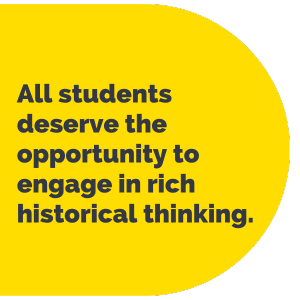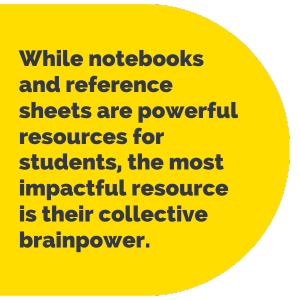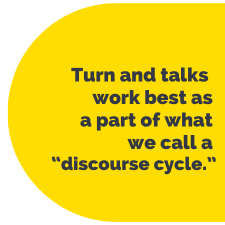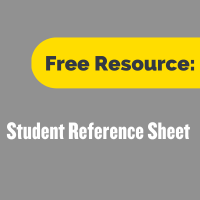Les professeurs d'histoire veulent que les élèves s'engagent profondément dans des sources primaires complexes. Pourtant, certains enseignants peuvent être réticents à confier ces textes en raison de leur complexité, en plus des inquiétudes concernant le niveau de lecture des élèves. Pourtant, tous les élèves méritent d'avoir l'opportunité de s'engager dans une réflexion historique riche. Grâce à une chute de connaissances stratégiquement placée, ainsi qu'à des ressources intentionnellement organisées, nous pouvons préparer les élèves à analyser les sources d'une manière qui maintient les exigences cognitives élevées et l'échafaudage faible.

Dans la quatrième partie de notre livre, Faites de l'histoire : Guide pratique pour l'enseignement de l'histoire au collège et au lycéeNous nous rendons dans la classe d'histoire des États-Unis de Scott Kern, en classe supérieure, pour voir ces mouvements à l'œuvre.
Connaissance de la chute
Pour l'enquête du jour, Scott a adapté la leçon du Stanford History Education Group, "Pourquoi la grève de Homestead a-t-elle tourné à la violence ?".* Pour répondre à cette question, les élèves analyseront deux documents de source primaire : un extrait de l'autobiographie de la militante socialiste Emma Goldman et une interview dans un journal du directeur d'usine Henry C. Frick.
Scott sait que les élèves ont suffisamment de contexte historique pour comprendre l'essentiel des deux sources, mais il anticipe un point sur lequel ils pourraient être bloqués. En regardant la vidéo ci-dessous, demandez-vous comment il les prépare à relever le défi.
En définissant un terme clé (détectives Pinkerton) juste avant que les élèves n'en aient besoin, Scott leur fournit les informations dont ils ont besoin pour débloquer les sources par eux-mêmes. Nous appelons ce mouvement "drop knowledge", que vous reconnaîtrez peut-être comme un type de "frontloading". Le frontloading donne aux élèves des définitions clés et/ou un contexte historique avant qu'ils n'en aient besoin, généralement au début d'une leçon. Cette démarche aide les élèves à naviguer de manière autonome dans des sources complexes, en l'occurrence, à s'attaquer à des perspectives différentes sur la grève du Homestead. Le Frontloading est généralement une action menée par l'enseignant. Essayez les actions suivantes pour donner plus de pouvoir aux élèves.
Notes pour les étudiants
Comme vous pouvez le voir dans la vidéo, les élèves de Scott ne sont pas des auditeurs passifs, mais des apprenants actifs. Pendant ses mini-leçons, ils consignent leur compréhension croissante sous forme de notes Cornell. Ces carnets constituent une ressource essentielle que les élèves peuvent utiliser pour replacer le document de source primaire dans son contexte historique. Dans ces notes, les élèves peuvent répondre à la question clé de savoir ce qui se passait à l'époque où le document a été produit et expliquer son objectif et/ou son public.
Les étudiants mettent régulièrement à jour leurs notes avec de nouvelles informations et sont très fiers de leur qualité et de leur propreté. Afin de maintenir le niveau de rétroaction élevé, Scott recueille et évalue périodiquement l'organisation et l'achèvement des notes.
Les carnets de notes organisés jettent les bases d'une histoire cohérente du passé. La ressource suivante les complète.
Fiches de référence pour les élèves
 Chaque élève de la classe de Scott dispose d'une feuille de référence, souvent appelée organisateur de connaissances, contenant des informations clés (dates, définitions, personnes) relatives à la révolution industrielle. Cette fiche est un support essentiel à l'apprentissage tout au long de l'unité. Les élèves l'utilisent pour répondre à des questions de base, ce qui libère leur réflexion pour aborder des questions plus profondes et permet à Scott de passer plus de temps à faciliter le discours et à accompagner la compréhension. Les fiches de référence aident également les élèves à hiérarchiser les connaissances les plus importantes au sein d'une unité et à les encoder dans leur mémoire à long terme au fil du temps. Nous avons inclus un exemple de fiche de référence pour vous, ici. (Pour plus d'informations sur la manière d'utiliser la recherche de connaissances pour renforcer l'apprentissage, lisez la partie 2 de l'article intitulé Faire l'histoire).
Chaque élève de la classe de Scott dispose d'une feuille de référence, souvent appelée organisateur de connaissances, contenant des informations clés (dates, définitions, personnes) relatives à la révolution industrielle. Cette fiche est un support essentiel à l'apprentissage tout au long de l'unité. Les élèves l'utilisent pour répondre à des questions de base, ce qui libère leur réflexion pour aborder des questions plus profondes et permet à Scott de passer plus de temps à faciliter le discours et à accompagner la compréhension. Les fiches de référence aident également les élèves à hiérarchiser les connaissances les plus importantes au sein d'une unité et à les encoder dans leur mémoire à long terme au fil du temps. Nous avons inclus un exemple de fiche de référence pour vous, ici. (Pour plus d'informations sur la manière d'utiliser la recherche de connaissances pour renforcer l'apprentissage, lisez la partie 2 de l'article intitulé Faire l'histoire).
Si les cahiers et les fiches de référence sont de puissantes ressources pour les élèves de la classe de Scott, la ressource la plus importante est sans doute leur force cérébrale collective. Pour ce faire, Scott a recours à une méthode qui a fait ses preuves : le "turn-and-talk".
Tourner et parler
Plutôt que de réserver les discussions des élèves pour la fin de l'exposé ou de la période de cours, Scott insère stratégiquement des tours de parole tout au long de la leçon. Cela donne aux élèves de multiples occasions de donner un sens à de nouvelles preuves et de repousser les limites de leur réflexion avec l'aide de leurs camarades. Cette création de sens collaborative met en évidence un point essentiel de l'apprentissage de l'histoire : c'est ensemble que nous pouvons le mieux donner un sens au passé. En examinant et en évaluant activement les points de vue et les preuves en partenariat, et en clarifiant les malentendus, les élèves parviennent à une compréhension plus nuancée.
c'est ensemble que nous pouvons le mieux donner un sens au passé. En examinant et en évaluant activement les points de vue et les preuves en partenariat, et en clarifiant les malentendus, les élèves parviennent à une compréhension plus nuancée.
Si vous n'êtes pas sûr de l'endroit où placer les tours de parole dans une leçon, utilisez les conseils suivants :
Les tours de parole peuvent être utilisés à n'importe quel moment d'une leçon, mais ils fonctionnent mieux dans le cadre de ce que nous appelons un "cycle discursif". (Voir la partie 4 de Faire l'histoire pour plus de détails). Voici une version condensée du cycle :
- Présentez le sujet : Il peut s'agir de la question historique centrale ou d'une question connexe.
- Demandez aux élèves d'examiner, de lire et d'annoter les preuves de manière indépendante.
- Demandez aux élèves de se retourner et de parler pour partager leurs idées et leurs questions.
- Après avoir circulé pour écouter et contribuer aux conversations, réunissez le groupe pour discuter de la réflexion menée dans la salle.
- Répétez le cycle si nécessaire pendant le reste de la leçon.
L'abandon des connaissances, la prise de notes, les fiches de référence et les tours de parole sont des moyens simples mais puissants qui aident les élèves à donner un sens au passé sans diluer la source. Pour plus de stratégies sur la façon d'améliorer l'accès des élèves, lisez les parties 2 à 4 de Faire l'histoire.
*1892, Homestead, Pennsylvanie : Lorsque les négociations salariales échouent entre les travailleurs de l'acier et le directeur de l'usine Carnegie Steel, Henry Frick, les travailleurs syndiqués déclarent la grève et encerclent l'usine. En réponse, Henry Frick envoie une milice armée pour reprendre l'accès à l'usine. Des coups de feu éclatent peu après.
Cliquez ci-dessous pour obtenir le PDF de la ressource mentionnée ci-dessus :



